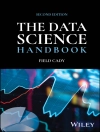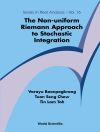Features modern research and methodology on the spread of infectious diseases and showcases a broad range of multi-disciplinary and state-of-the-art techniques on geo-simulation, geo-visualization, remote sensing, metapopulation modeling, cloud computing, and pattern analysis
Given the ongoing risk of infectious diseases worldwide, it is crucial to develop appropriate analysis methods, models, and tools to assess and predict the spread of disease and evaluate the risk. Analyzing and Modeling Spatial and Temporal Dynamics of Infectious Diseases features mathematical and spatial modeling approaches that integrate applications from various fields such as geo-computation and simulation, spatial analytics, mathematics, statistics, epidemiology, and health policy. In addition, the book captures the latest advances in the use of geographic information system (GIS), global positioning system (GPS), and other location-based technologies in the spatial and temporal study of infectious diseases.
Highlighting the current practices and methodology via various infectious disease studies, Analyzing and Modeling Spatial and Temporal Dynamics of Infectious Diseases features:
* Approaches to better use infectious disease data collected from various sources for analysis and modeling purposes
* Examples of disease spreading dynamics, including West Nile virus, bird flu, Lyme disease, pandemic influenza (H1N1), and schistosomiasis
* Modern techniques such as Smartphone use in spatio-temporal usage data, cloud computing-enabled cluster detection, and communicable disease geo-simulation based on human mobility
* An overview of different mathematical, statistical, spatial modeling, and geo-simulation techniques
Analyzing and Modeling Spatial and Temporal Dynamics of Infectious Diseases is an excellent resource for researchers and scientists who use, manage, or analyze infectious disease data, need to learn various traditional and advanced analytical methods and modeling techniques, and become aware of different issues and challenges related to infectious disease modeling and simulation. The book is also a useful textbook and/or supplement for upper-undergraduate and graduate-level courses in bioinformatics, biostatistics, public health and policy, and epidemiology.
Cuprins
Foreword ix
Nicholas Chrisman
Acknowledgements xi
Editors xiii
Contributors xv
PART I OVERVIEW
1 Introduction to Analyzing and Modeling Spatial and Temporal Dynamics of Infectious Diseases 3
Dongmei Chen, Bernard Moulin, and Jianhong Wu
2 Modeling the Spread of Infectious Diseases: A Review 19
Dongmei Chen
PART II MATHEMATICAL MODELING OF INFECTIOUS DISEASES
3 West Nile Virus: A Narrative from Bioinformatics and Mathematical Modeling Studies 45
U.S.N. Murty, Amit K. Banerjee, and Jianhong Wu
4 West Nile Virus Risk Assessment and Forecasting Using Statistical and Dynamical Models 77
Ahmed Abdelrazec, Yurong Cao, Xin Gao, Paul Proctor, Hui Zheng, and Huaiping Zhu
5 Using Mathematical Modeling to Integrate Disease Surveillanceand Global Air Transportation Data 97
Julien Arino and Kamran Khan
6 Malaria Models with Spatial Effects 109
Daozhou Gao and Shigui Ruan
7 Avian Influenza Spread and Transmission Dynamics 137
Lydia Bourouiba, Stephen Gourley, Rongsong Liu, John Takekawa, and Jianhong Wu
PART III SPATIAL ANALYSIS AND STATISTICAL MODELING OFINFECTIOUS DISEASES
8 Analyzing the Potential Impact of Bird Migration on the Global Spread of H5N1 Avian Influenza (2007-2011) Using Spatiotemporal Mapping Methods 163
Heather Richardson and Dongmei Chen
9 Cloud Computing-Enabled Cluster Detection Using a Flexibly Shaped Scan Statistic for Real-Time Syndromic Surveillance177
Paul Belanger and Kieran Moore
10 Mapping the Distribution of Malaria: Current Approaches and Future Directions 189
Leah R. Johnson, Kevin D. Lafferty, Amy Mc Nally, Erin Mordecai, Krijn P. Paaijmans, Samraat Pawar, and Sadie J. Ryan
11 Statistical Modeling of Spatiotemporal Infectious Disease Transmission 211
Rob Deardon, Xuan Fang, and Grace P.S. Kwong
12 Spatiotemporal Dynamics of Schistosomiasis in China:Bayesian-Based Geostatistical Analysis 233
Zhi-Jie Zhang
13 Spatial Analysis and Statistical Modeling of 2009 H1N1Pandemic in the Greater Toronto Area 247
Frank Wen, Dongmei Chen, and Anna Majury
14 West Nile Virus Mosquito Abundance Modeling Using Nonstationary Spatiotemporal Geostatistics 263
Eun-Hye Yoo, Dongmei Chen, and Curtis Russel
15 Spatial Pattern Analysis of Multivariate Disease Data283
Cindy X. Feng and Charmaine B. Dean
PART IV GEOSIMULATION AND TOOLS FOR ANALYZING AND SIMULATINGSPREADS OF INFECTIOUS DISEASES
16 The Zoonosis MAGS Project (Part 1): Population-Based Geosimulation of Zoonoses in an Informed Virtual Geographic Environment 299
Bernard Moulin, Mondher Bouden, and Daniel Navarro
17 Zoonosis MAGS Project (Part 2): Complementarity of a Rapid-Prototyping Tool and of a Full-Scale Geosimulator for Population-Based Geosimulation of Zoonoses 341
Bernard Moulin, Daniel Navarro, Dominic Marcotte, Said Sedrati, and Mondher Bouden
18 Web Mapping and Behavior Pattern Extraction Tools to Assess Lyme Disease Risk for Humans in Peri-urban Forests 371
Hedi Haddad, Bernard Moulin, Franck Manirakiza, Christelle M´eha, Vincent Godard, and Samuel Mermet
19 An Integrated Approach for Communicable Disease Geosimulation Based on Epidemiological, Human Mobility and Public Intervention Models 403
Hedi Haddad, Bernard Moulin, and Marius Thériault
20 Smartphone Trajectories as Data Sources for Agent-based Infection-spread Modeling 443
Marcia R. Friesen and Robert D. Mc Leod
Index 473
Despre autor
Dongmei Chen, Ph D, is Associate Professor in the Department
of Geography and Director of the Laboratory for Geographic
Information and Spatial Analysis at Queen’s University,
Canada.
Bernard Moulin, Ph D, is Professor in the Department of
Computer Science and Software Engineering at Laval University,
Canada.
Jianhong Wu, Ph D, is Canada Research Chair and University
Distinguished Research Professor in the Department of Mathematics
and Statistics and Director of the Center for Disease Modeling at
York University, Canada.












